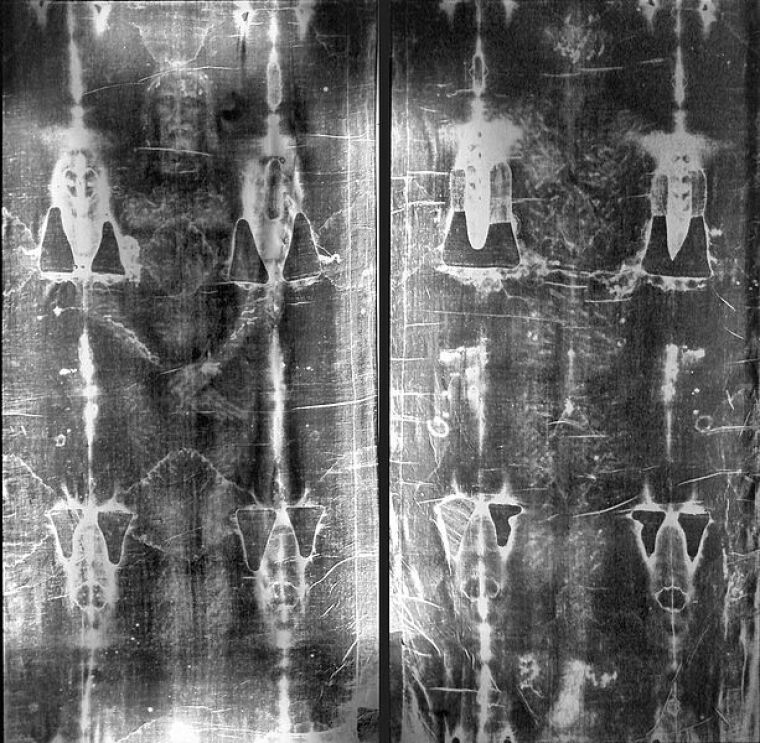Researchers discover blood of torture victim on Shroud of Turin

Researchers have discovered that the Shroud of Turin, which is believed by some to be the burial cloth of Jesus Christ, contains the blood of a torture victim.
Elvio Carlino, a researcher at the Institute of Crystallography, noted that very small particles attached to the linen fibers of the shroud "have recorded a scenario of great suffering, whose victim was wrapped up in the funeral cloth."
According to Giulio Fanti, a professor at the University of Padua, the particles, called "nanoparticles," had a "peculiar structure, size and distribution" that are not typical of the blood of a healthy person.
The nanoparticles reportedly show high levels of substances called creatinine and ferritin, which can be found in patients who have suffered multiple traumas such as torture.
"Hence, the presence of these biological nanoparticles found during our experiments point to a violent death for the man wrapped in the Turin Shroud," said Fanti, according to Catholic News Agency.
The latest findings have been published in the U.S. open-access peer-reviewed journal PlosOne, in an article titled "New Biological Evidence from Atomic Resolution Studies on the Turin Shroud."
Carlino stated that the new findings could only be "revealed by the methods recently developed in the field of electron microscopy." He further noted that the research marked the first study of "the nanoscale properties of a pristine fiber taken from the Turin Shroud."
The research was conducted by the Istituto Officina dei Materiali in Trieste and the Institute of Crystallography in Bari, which are both under Italy's National Research Council and the University of Padua's Department of Industrial Engineering.
While some have claimed the relic to be a forgery, the researchers maintain that there is no evidence so far to suggest that the shroud is a fake.
The 14-foot long, three-and-a-half foot wide cloth features a postmortem image of a man who appeared to be brutally tortured and crucified.
Earlier this year, Italy's National Agency for New Technologies, Energy and Sustainable Economic Development published a report noting that the image on the cloth cannot be reproduced with the current state of science.
According to the report, the total power required to instantly color the surface of the linen that corresponds to the size of an average human body would be "34 thousand billion watts."
The document further explained that it would be impractical to reproduce the entire image on the Shroud today, noting that the most powerful light source available on market only goes as high as several billion watts.
The Catholic Church has not taken an official position on the authenticity of the shroud, which is currently housed at Turin's St. John the Baptist Cathedral.
 Christians don't have to affirm transgenderism, but they can’t express that view at work: tribunal
Christians don't have to affirm transgenderism, but they can’t express that view at work: tribunal Archaeology discovery: Medieval Christian prayer beads found on Holy Island
Archaeology discovery: Medieval Christian prayer beads found on Holy Island Presbyterian Church in America votes to leave National Association of Evangelicals
Presbyterian Church in America votes to leave National Association of Evangelicals Over 50 killed in 'vile and satanic' attack at Nigerian church on Pentecost Sunday
Over 50 killed in 'vile and satanic' attack at Nigerian church on Pentecost Sunday Ukrainian Orthodox Church severs ties with Moscow over Patriarch Kirill's support for Putin's war
Ukrainian Orthodox Church severs ties with Moscow over Patriarch Kirill's support for Putin's war Islamic State kills 20 Nigerian Christians as revenge for US airstrike
Islamic State kills 20 Nigerian Christians as revenge for US airstrike Man who served 33 years in prison for murder leads inmates to Christ
Man who served 33 years in prison for murder leads inmates to Christ


 Nigerian student beaten to death, body burned over ‘blasphemous’ WhatsApp message
Nigerian student beaten to death, body burned over ‘blasphemous’ WhatsApp message 'A new low': World reacts after Hong Kong arrests 90-year-old Cardinal Joseph Zen
'A new low': World reacts after Hong Kong arrests 90-year-old Cardinal Joseph Zen Iran sentences Christian man to 10 years in prison for hosting house church worship gathering
Iran sentences Christian man to 10 years in prison for hosting house church worship gathering French Guyana: Pastor shot dead, church set on fire after meeting delegation of Evangelicals
French Guyana: Pastor shot dead, church set on fire after meeting delegation of Evangelicals ‘Talking Jesus’ report finds only 6% of UK adults identify as practicing Christians
‘Talking Jesus’ report finds only 6% of UK adults identify as practicing Christians Mission Eurasia ministry center blown up in Ukraine, hundreds of Bibles destroyed: 'God will provide'
Mission Eurasia ministry center blown up in Ukraine, hundreds of Bibles destroyed: 'God will provide' Church holds service for first time after ISIS desecrated it 8 years ago
Church holds service for first time after ISIS desecrated it 8 years ago Burger King apologizes for 'offensive campaign' using Jesus' words at the Last Supper
Burger King apologizes for 'offensive campaign' using Jesus' words at the Last Supper Uganda: Muslims abduct teacher, burn him inside mosque for praying in Christ’s name
Uganda: Muslims abduct teacher, burn him inside mosque for praying in Christ’s name